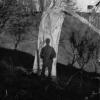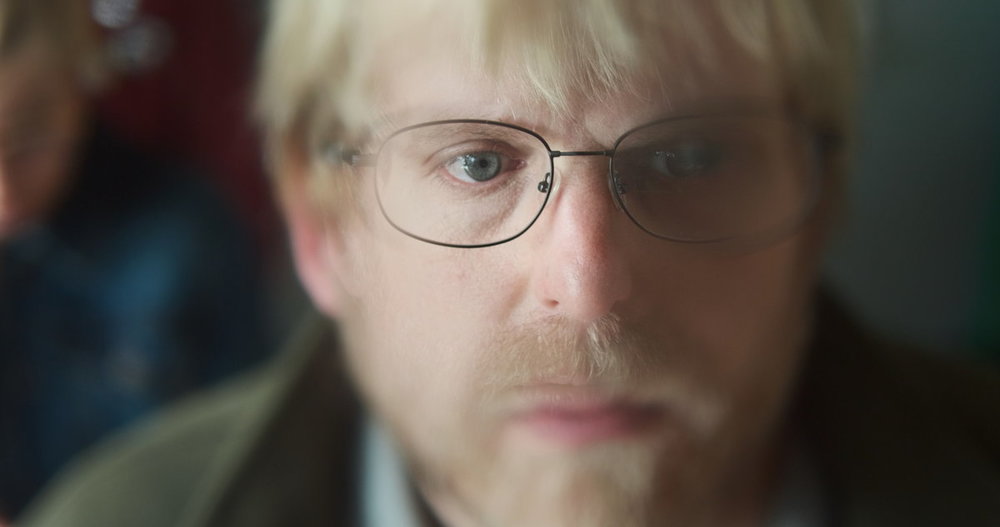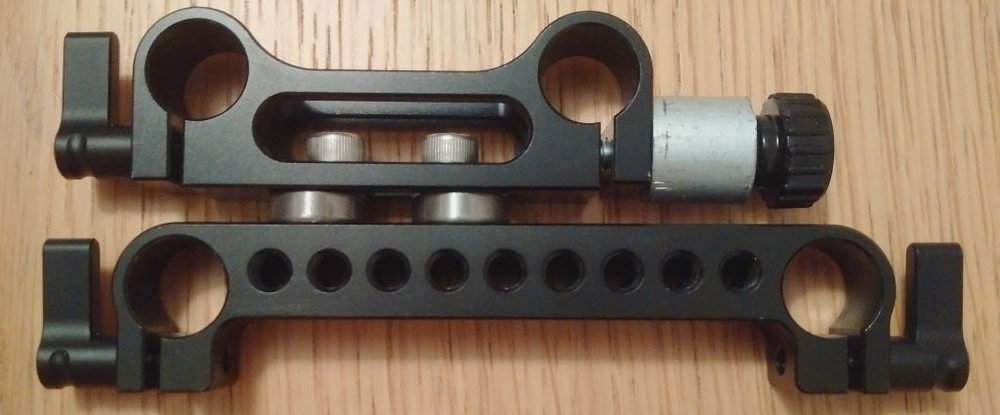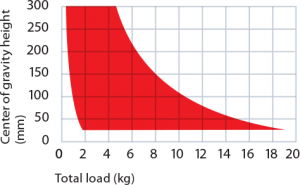-
Posts
146 -
Joined
-
Last visited
Everything posted by Daniel Klockenkemper
-
The aperture works exactly the same; depth of field, exposure, etc. will behave as they normally would. You can think of it as extracting the central 1/3 of a 135 stills frame. To tell you how I learned the hard way: I once borrowed a Nikkor 55mm f/1.2 for a shoot, hoping it'd be a bit more similar to the Kowa 16mm primes in terms of the coatings and the stop. While passable wide open for full-frame stills, on 16mm the chromatic aberrations were proportionally larger since the area of the negative being used is smaller. I went back to my Contax lenses after that - the Zeiss 50mm/1.7 was usable wide open, so it wasn't worth keeping the Nikkor if it'd need to be stopped down anyway. It almost sounds like circular logic - the better your lenses are, the better they'll look on smaller film formats.
-
This is no problem at all. I used a c-mount to Contax adapter all the time when I had an Eclair. Coverage is not an issue, since the 135 stills format is much larger than 16mm. The only minor caveat is that, because the diagonal measurement of 16mm is almost 3 times smaller than 135, the image from the lens is effectively magnified 3x. So if the lens has some aberrations, they will be much more apparent than what you might be used to from stills or video from larger formats. I'm sure you're aware that c-mount lenses can become unscrewed if the lens is torqued; this shouldn't be a problem if your lenses are properly lubricated and the focus turns smoothly. On the other side of the adapter, the lens can shift in the mount of a stills bayonet mount since they are not positive locking. If your adapter and lenses are in good shape, you shouldn't have to worry about this either. Other than that, enjoy having lots of longer focal lengths to work with.
-

Diopters for aesthetics not close focus
Daniel Klockenkemper replied to Pete Raynell's topic in General Discussion
While 'personal shooting quirk' satisfies Occam's razor, it's definitely interesting to speculate what the reasoning behind the decision is. For the most part, lenses designed before the 1990s had their best performance when focused at infinity - aberrations, especially away from the center of the frame, increased at the closer distances where filming normally takes place. (Optimal performance at closer distances was a big selling point of the Ultra Primes.) So perhaps the idea was to use the lenses closer to their 'sweet spot,' ignoring the effect that adding a diopter has on lens performance? Of course, the minor side effects of adding an extra, presumably uncoated, lens to the optical path could be the entire point, too. This is the other possibility I can think of. Like many older lens designs, most of the Zeiss Contax lenses focus by moving the entire lens away from the focal plane; and the closer you need to focus, the further the lens has to be moved (which is why the closer distances are spaced further apart on the ring). So when the diopter is added, perhaps the optics don't need to move as far to change focus, which could reduce breathing. -

What the heck is this Angenieux zoom mount?
Daniel Klockenkemper replied to Greg Lee's topic in Lenses & Lens Accessories
From the pictures on this site, it looks like the c mount is attached to the back of the lens, and you're missing that piece: http://www.bigeye.url.tw/big5/d_ange17_68_22.htm -
If you're looking for a modern style of head with adjustable counterbalance, there's unfortunately a large gulf between the affordable heads and the heads that can handle a higher payload. You're right to look on the used market. Something like an old OConnor 30 doesn't have an adjustable counterbalance, but it's from the same era as the NPR and would probably work rather well. When I owned an ACL, I used a higher-end Libec head - they're often overlooked because most Libec gear is aimed either at the low end or towards broadcast studios. A used H70, H80, H85, or even H100 could likely be found at a much cheaper price than an equivalent head from another manufacturer. Since you're in the UK, you might be able to more readily find a Vinten Vision 22SD - it's a substantially larger head, but would easily handle the weight of the NPR. Though like any used, older head, spare parts are going to be difficult if not impossible to find should anything need repair. For any head, be mindful of the stated weight capacity - it's usually quoted for a low center of gravity, while film cameras' C.G.s are much higher, meaning the maximum payload is much lower.
-
CVP has an excellent web app to check illumination circles for various combinations of cameras and lenses: https://cvp.com/tools/cameralens The Fujinon MK lenses aren't listed in the tool, but from what I recall they only cover the 4k S35 crop mode on the FX9, and vignette on 5k. As for FS7 vs FX9 4k - it's 2012 vs 2020 sensor technology. Even without oversampling I'd expect the FX9 to have better overall performance.
-
Hi Toto! The plates look quite good to me, I especially like the compact top handle. One small thought about the handle, you might also add mounting positions for the tape hook on the left and right handle sides as well to provide some different options. To everyone else, I've known Toto for quite a while, and worked with him several times going all the way back to film school. I have great trust in his design expertise, and I believe the thought he's put into these accessories is obvious. I'd certainly be interested if I owned an SR3. ?
-

Can someone identify the problem with this Aaton mag?
Daniel Klockenkemper replied to Simon Gulergun's topic in Aaton
For starters, tell them not to tape the film to the core. It's hard to make an exact diagnosis from the pictures. Certainly, the film coming out of the lower sprocket started to accordion and got sucked into the upper sprocket. But without physically inspecting the magazine, I can only guess that it was either loaded incorrectly - most of the time, it's from not following the film path correctly, too much slack somewhere, not closing the sprocket guides, etc. - or that there's some mechanical issue like the belt slipping or a gear being broken. Has your friend tried turning the magazine without film? The take-up spindle and the two sprockets should all turn together if you rotate the spindle counter-clockwise. What happens when you thread in the film, place the magazine on the camera with the take-up door open, and run the camera at 1 fps? -
Skyfall, released in 2012, came out in the middle of the theatrical transition to digital projection. (In Jan. 2011 there 16,522 digital screens in the USA and Canada; by March 2015, the number in the USA alone had increased to 38,719, which was about 97% of US screens according to Wikipedia.) They probably thought there were enough unconverted screens that a small number of prints was still worthwhile. I actually saw a 35mm print of Skyfall in a discount theater, I think it was a $3 ticket, and it was a strange experience. The print was very beat up and had noticeable scratching, but I was sitting close enough to the screen that I could see pixels! It really wasn't the ideal way to experience the film.
-
I agree 100% with Tristan. You need someone who is not just adept at rigging, but rigging to automobiles. Every car is built differently, and will pose a different challenge because of that. Especially with a camera package upwards of 40 pounds - this is well beyond a GoPro suction cupped to a windshield. There are so many qualified people in LA; and with so many of those people out of work right now, you should have no trouble finding someone eager to take a gig! Even with proper rigging, I hope you're aware of the increased safety concerns inherent in driving shots, and with hostess trays in particular. Actors are not professional drivers. Since your actor is concentrating on their performance, their road awareness can easily suffer - it must be stressed to the actor that they are piloting a vehicle first and foremost, and that everything else must be a lower priority. I always make a point of communicating this personally to the driver, to be absolutely sure that it has been communicated. On top of that, a hostess tray makes a vehicle ~2ft wider on one side, which will require even greater road awareness. (Along with considerations in route planning, lead and follow vehicles / traffic control, etc. You do have a permit, right?) Any hostess tray or vehicle mount, regardless of payload, needs to be checked after every pass to make sure it is still correctly secured. Rigging the camera properly, as well as changing camera position, will also take more time than you think. Be sure to communicate this to your 1st AD and production team, so that everyone has reasonable expectations going in.
-
Your question, "What are 'good' lens flares?" is definitely a matter of opinion! You should read this interview in Film and Digital Times with Christophe Casenave and Dr. Benjamin Völker, respectively a Product Manager and Optical Designer at Zeiss, regarding the design process of the Supreme Prime Radiance lenses, which are intended to flare in a specific way (in contrast to the non-radiance Supreme Prime lenses, which control flares very well). They compare lens characteristics to wine tasting. Personally, I agree with Stuart; for me it's less important what a lens flare looks like, and more important what intention (if any) its presence indicates. I dislike flares that are purely decorative picture elements. One of my favorite examples of intentional lens flare is the martial arts classic A Touch of Zen, which has no lens flares at all except for the scenes where Buddhist monks show up; those scenes specifically incorporate a variety of lens flares into their mise-en-scène: https://youtu.be/0AHz2B-_sLQ?t=119
-

For Sale: Eclair ACL II kit
Daniel Klockenkemper replied to Daniel Klockenkemper's topic in Cine Marketplace
It's been brought to my attention that the pictures and details from my listing are being re-used by scammers. Because scammers copy legitimate sales posts, the scam often looks very convincing at first, though small red flags can still give it away - in this case, the scammer using my pictures had horizontally flipped them (probably to defeat a reverse google image search), and was also out of the country while negotiating the deal. I had no issue with speaking to buyers by phone or video chat, providing additional details and pictures upon request, and backing up the details with documentation. Any legitimate seller would be understanding of a buyer's caution, and should be willing to verify their legitimacy in a similar way. Please be cautious, and heed the advice of the scam warning at the top of this forum: https://cinematography.com/index.php?/topic/71998-be-careful-of-scams/ -

How to strike a 5k tungsten fresnel
Daniel Klockenkemper replied to Bradley Mowell's topic in Lighting for Film & Video
Here's the relevant quote from p. 308 of the Set Lighting Technician's Handbook (4th ed.) by Harry Box: I can't find any mentions of requiring a dimmer for tungsten fixtures smaller than a 20k. I've seen a dimmer board op 'sneak' up 10k fresnels out of an abundance of caution in an older installation. I've never seen anyone bother with this for a 5k, and can't remember ever having a problem striking a 5k right from the switch. -
http://www.tinyurl.com/cinelenses is one of the most extensive compilations of available cinema lens makes, models, and technical data, though it may be impossible to keep up with every rehousing variation. The Vantage T1 lenses don't cover full frame, but you should note that Vantage has a new, similar lineup of full frame lenses called One4: https://www.vantagefilm.com/file/edee/2020/07/vantageone4-20200710-010154.pdf Might I ask what particular optical qualities you're searching for? "Vintage" just means old, and just because a lens is old doesn't mean that it's optical quality is poor. If you want lenses that are closer to peering through a cola bottle, there are modern lenses that might fit your criteria, too.
-

Dumb Question: Can I switch lens in the middle of a 400’ roll?
Daniel Klockenkemper replied to Raymond Zrike's topic in 16mm
Yes, you can. Even if your motor isn't the mirror parking model, at most you'll only expose one frame (and that frame will be overexposed anyway because the motor was slowing to a stop). The anti-halation backing prevents light from propagating too much into adjacent frames. It's a good idea to make sure the shutter is closed though, so that dust doesn't find its way into the gate. You can also switch magazines in the middle of a roll (to change from low speed to high speed stock, for instance). You would flash about 14 frames. -
I've made up brackets like this for when I've had to mix lightweight and studio components. There are lots of inexpensive rod clamps available these days, so customizing things to your needs is easier than ever before. Of course, you might have to budget a generous amount of time for inexpensive parts to come from overseas; if you need something quickly it's always more expensive. What matte box are you trying to use? It's a bit unusual for Super 16 accessories to be studio format; almost all of the S16 cameras I've used have been primarily set up for 15mm lightweight rods.
-

Image Circle List
Daniel Klockenkemper replied to Sandra Coulson's topic in Camera Assistant / DIT & Gear
CVP maintains the most extensive catalog I've encountered so far, and includes images taken with each lens so you can see the illumination falloff for yourself: https://cvp.com/tools/cameralens -

Difference between Arri LWZ and Arri Alura
Daniel Klockenkemper replied to Uli Meyer's topic in Lenses & Lens Accessories
One piece of advice I've heard - the more similar two choices are, the less it matters which you choose, since the results will be similar in the end. I think that applies here, since the two lenses are incredibly similar in almost every way - practically zero breathing, with negligible distortion or other aberrations. It's like they were designed to meet the same specification... On paper, the only notable difference between them is that the LWZ has an interchangeable mount option. While I generally have a slight preference for Zeiss, sometimes I prefer a different look for a project. Is there any way you could get both lenses together in the same room with your film camera? Personally, I've found it much easier to determine my feelings and preference between two lenses when looking at each of them through a ground glass. -
Hi Elliott, I'm guessing you're going to be shipping your film somewhere else for processing. Film is pretty resilient. The worst that could happen is that the film in the center of the reel relaxes a little bit and has some room to move around; as a result, any bits of dust or debris that's currently sandwiched between the emulsion and the base could possibly make small scratches if the film moves around as the reel becomes less taught during transport. If you have to send it to the lab this way, make sure you note that the core is missing before you send it to the lab. I think lab employees appreciate it when you tell them about darkroom surprises in advance. ? If you have some time to deal with it before you ship the film - If that reel didn't roll out during the middle of a performance (which, if it did, you should mark that roll as having a 'critical end'), you could always trim a tiny bit of film out from the center, and the core should be able to fit in the center of the roll again.
-

Spot meter use cases
Daniel Klockenkemper replied to Brian E. Rutan's topic in Lighting for Film & Video
Hi Brian, There's certainly both a technical and philosophical difference between the two - the incident meter tells you how much light is traveling through a particular point in space on set, while a spot meter tells you the actual amount of light reflecting off of a subject towards the camera position. If you wanted to indulge your inner Ansel Adams and think in terms of the zone system, a spot meter would be the way to go. If you know your acquisition medium well enough, it might be possible to use a spot meter exclusively. But in practice, I've almost always relied on my incident meter. In the not so distant past, when I filmed on film and had separate spot and incident meters, I would take out my spot meter mainly to check a practical or a very saturated color to check that was within the stock's dynamic range. Using a reflected meter requires advance knowledge of your capture medium's dynamic range / tone response in order to be truly useful. With digital cameras, a waveform meter that's interpreting the camera's log response can replace a spot meter, and saves you some of the trouble of interpreting how a scene-reflected value corresponds to a camera tone / code value. The last couple Sekonic meters I've owned have had both functions in one, so sometimes it's faster to just spot meter something from where I'm standing than to walk back to the camera or the DIT station and bring up a waveform. There is some marginal value to having a second meter on hand to check the meters' measurements against one another - I did have an incident meter fail on me in the middle of production once. But if you can only afford one meter for now, I'd say your money would be better spent having your incident meter calibrated to ensure that it's accurate. -
Hello Kitae, thank you for posting your tests! It's always good to see what the results look like in the real world - we get a much better sense of each camera's performance by watching the video, versus comparing unofficial estimates. I also find it frustrating that this information is not published by most manufacturers. Readout speed is a factual, quantifiable number, just like resolution, bit rate, or power draw. One would think that manufacturers with low rolling shutter numbers would want to promote it. There's a long-running thread on DVXuser.com with a list of rolling shutter figures: http://www.dvxuser.com/V6/showthread.php?303559-Measuring-rolling-shutter-put-a-number-on-this-issue! Though those figures might not be entirely accurate, the people involved seem to have done their best to get as close as they can. Cinema5D.com has recently changed their method for measuring rolling shutter, filming a 300Hz strobe and counting the number of pulse lines per frame. This seems like a repeatable method that will be much more accurate than guessing based on panning a camera back and forth. Unfortunately, they've tested very few cameras with their new method. It could be possible to construct a portable 300Hz strobe tester - something like an Expodisc diffuser with an LED strobe behind it, that could cover the front of a lens and be taken to a trade show (whenever we have public trade shows again!), rental house, or retail showroom. If we have to measure these numbers ourselves, it would be best if we could eliminate the guess work.
-

Lightest Tripod + Head for use with Arriflex 235
Daniel Klockenkemper replied to Uli Meyer's topic in Grip & Rigging
This is extremely unlikely to work. The counterbalance capacity of a tripod head depends on the center of gravity height for the payload. Film cameras have a much higher CoG, so the payload capacity is much reduced. And putting a film camera on a 75mm ball base would be asking for trouble. ? I concur with Phil, something like a Sachtler Video 20 or Miller ArrowX 7 might be the minimum one could get away with using a lighter film camera like the 235, but they'd probably be right at the upper limit. I also advise testing your heaviest build, with a full dummy load in your most top-heavy magazine. I used the highest-end Vision head (in non-HD version) once with a Moviecam Compact with carbon fiber magazine and prime lens - it just barely worked with the magazine in the rear position; the top mount was too much for it to handle. -

2x extender with 2x anamorphic?
Daniel Klockenkemper replied to Hannes Famira's topic in Lenses & Lens Accessories
There is a thread on this topic from 2015, Dom Jaeger gives a nice explanation:







